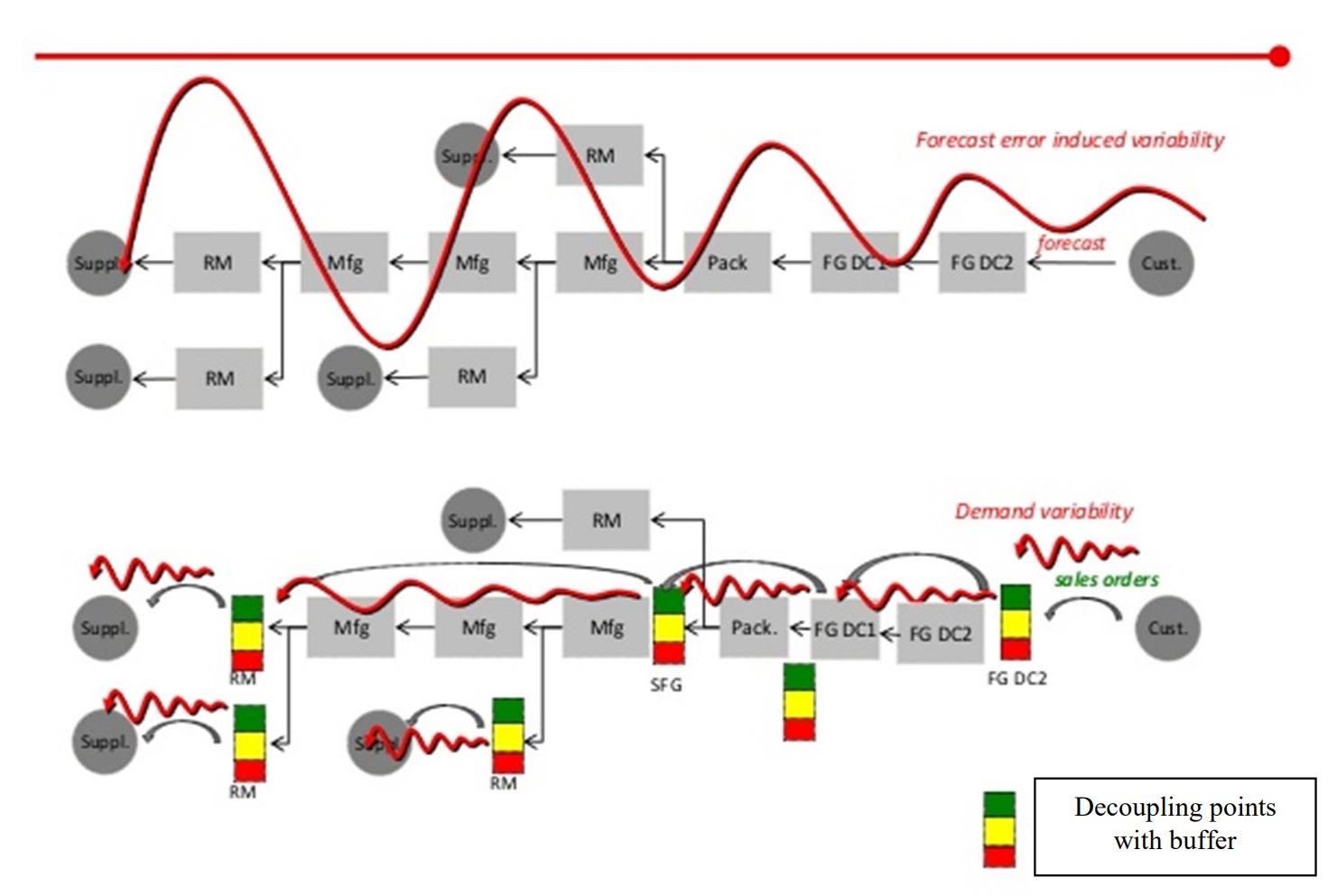Decoupling is a technique used for Demand Driven Material Requirements Planning, which can create independence between the supply of material and its use. This is a key principle thanks to which the DDMRP allows you to pre-position strategic stocks to ensure responsiveness to demand, manage supply priorities in an organized manner and stabilize flow at points of weakness.
Whatis decoupling?
Decoupling or decoupling is commonly understood as the strategy according to which intermediate inventories of materials, components and finished products are located along the supply chain. Using these inventories, the fluctuations caused by the rearrangement of materials do not limit production and the bullwhip effect is reduced (source).
These intermediate inventories are defined as buffers, that is, the amount of material or semi-finished products that are expected to be consumed in the lead time considered, which in turn is the time necessary to produce new material added to a useful safety interval in the event of consumption errors.
The buffers are defined according to different parameters (variability, lead time, etc.) and in these points the explosion of the conventional MRP is decoupled. These buffers are managed with the DDMRP method, which uses actual demand to create precise orders while ensuring material availability and at the same time reducing the quantities of materials in inventories.
The heart of this solution therefore are the decoupling points, which decouple the Bill Of Materials (also known simply as BOM) and include the buffer of materials necessary to ensure the availability of materials at the points themselves.

Establish decoupling points
Decoupling or decoupling points, therefore, break the dependence on the bill of materials (or MRP pegging), stabilize the flow and eliminate the bullwhip effect.
The introduction of decoupling points also means that the lead time is divided into the so-called decoupled lead time. Shorter lead time reduces planning error, increases flexibility, brings competitive advantages to the market, and other benefits.
An example of decoupling in production
As seen, stock decoupling allows production phases to operate independently in the event of slowdowns or outages. Let’s see an example to understand how this happens.
Consider a computer manufacturer who must install the CPU before inserting the video card. Unfortunately a scheduled CPU delivery is blocked and will arrive a week late. Without decoupling, all orders that have not passed the CPU installation phase would not be fulfilled until the inventory is replenished. Instead, decoupling inventory allows you to have a stock of CPU to draw from to complete orders, avoiding backlogs, canceled orders, and dissatisfied customers.
The benefit of decoupling
With the DDMRP, on the other hand, carefully positioned decoupling buffers ensure the availability of materials on these points, avoiding the bullwhip effect and stock breaks. Moreover, thanks to the decoupling points, those responsible for the planning and supply of materials are able to know at all times what the situation of their supply chain is about the materials that will serve to meet the demand in the short and medium term. This allows them to act on time and proceed to order materials and components on time, improving On Time Delivery and service level.
In short, thanks to the supply of DDMRP, the demand signal is much more appropriate, the relevant data is transmitted along the production chain and the lead time to serve the customer is immediately reduced thanks to the fact that the time needed to respond to the market is reduced to the last fraction.
Pipeline inventory and decoupling
Pipeline inventory is an inventory composed of raw materials to assemble components or a finished product, which is located within the supply chain without having yet reached the final destination. As long as it is intransito and as long as the customer does not receive it and does not pay for it, it is considered part of the manufacturing company’s inventory. Once the materials arrive at the customer and are accounted for, this inventory is subtracted from the sender’s warehouse and added to the customer’s warehouse.
However, even if the materials are owned by the sender until they arrive at their final destination, customer companies still need to calculate pipeline inventory to keep track of resources and overhead costs. Pipeline inventory is calculated as the multiplication between lead time and demand rate.
Pipeline decoupling and inventory serve very different purposes, although they have some similarities, such as:
- They serve to improve operational efficiency: in fact, they allow normal operations to continue even when resources are not available.
- They mitigate the negative impact of lack of stock, compensating for lost time.
- They provide semi-finished products.
- Generate more accurate inventory data.
But, as mentioned, they serve different purposes. In fact, they also have some differences:
Decoupling is an internal system, an operational management strategy to eliminate bottlenecks typically used only by very large manufacturers. In addition, decoupling inventory is stored on site.
Instead, pipeline inventory is an externally implemented business process and typical in many more types of companies. Inventory then exists only outside the company.
Use the decoupling technique in your supply chain
Thanks to CyberPlan’s Demand Driven MRP solution, today you can use the decoupling technique within your company and obtain all the benefits that DDMRP is able to bring to the production department. Ask your questions and get your questions answered by contacting a DDMRP expert.
